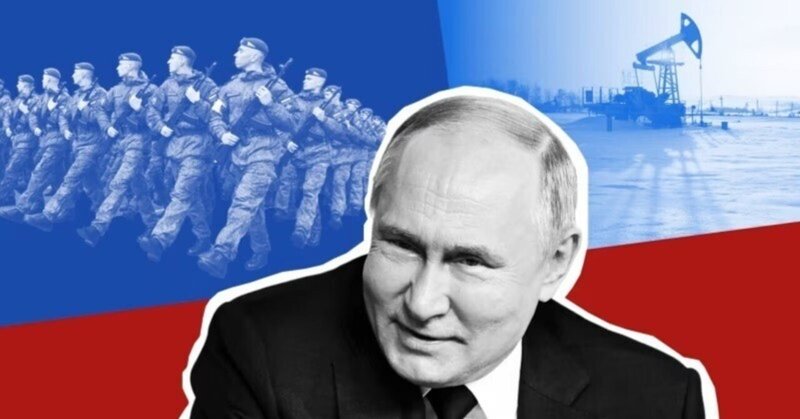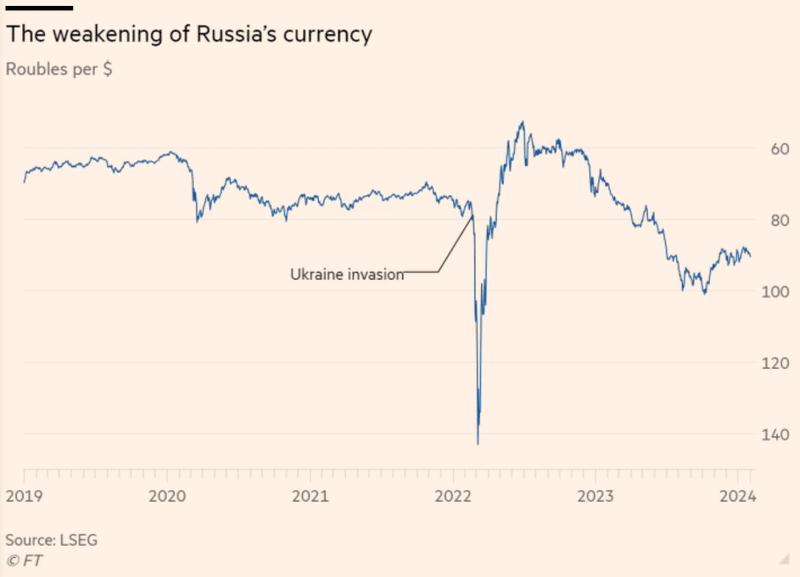
ロシア経済の驚くべき回復力/FTを読む
The surprising resilience of the Russian economy
ロシア経済の驚くべき回復力
Heavy public spending on defence has led to a rebound in growth but could also be storing up problems for the near future
国防への多額の公的支出は成長の回復につながったが、近い将来に向けて問題を蓄積させる可能性もある
Addressing a crowd of activists on Friday in Tula, the capital of Russia’s arms industry, Vladimir Putin crowed that the country’s economy had defeated western sanctions imposed after his invasion of Ukraine.
ウラジーミル・プーチン大統領は金曜日、ロシア軍需産業の首都トゥーラで大勢の活動家を前に演説し、同国の経済はウクライナ侵攻後に課せられた西側諸国の制裁を打ち破ったと叫んだ。
“They predicted decline, failure, collapse — that we would stand back, give up, or fall apart. It makes you want to show [them] a well-known gesture, but I won’t do that, there are a lot of ladies here,” Putin said to a round of applause. “They won’t succeed! Our economy is growing, unlike theirs.”
「彼らは衰退、失敗、崩壊を予測していた。彼らによく知られたジェスチャーを見せたくなるが、そんなことはしない、ここにはたくさんの女性たちがいるのだから」とプーチンは拍手喝采の中で語った。「彼らは成功しないだろう!私たちの経済は成長している。
Russia’s president gloated that Russia’s economy had not only withstood an onslaught of sanctions from western countries — but was now bigger than all but two of them. He was referring to the World Bank’s ranking of GDP by purchasing power parity, by which Russia slightly edges ahead of Germany. “All of our industry did their part,” he said.
ロシア大統領は、ロシア経済は西側諸国からの制裁の猛攻撃に耐えただけでなく、西側諸国のうち2カ国を除くすべての国よりも経済規模が大きくなったとほくそ笑んだ。これは世界銀行が発表した購買力平価によるGDPランキングのことで、ロシアはドイツをわずかに上回っている。「我々の産業はすべて、それぞれの役割を果たした」と彼は言った。
On Tuesday, the IMF appeared to concur with Russia’s president. The IMF revised its own GDP growth forecast for Russia to 2.6 per cent this year, a 1.5 percentage point rise over what it had predicted last October.
火曜日、IMFはロシア大統領に同意したようだ。IMFはロシアの今年のGDP成長率予測を2.6%に修正し、昨年10月の予測より1.5ポイント上昇させた。
The Russian economy’s resilience has stunned many economists who had believed the initial round of sanctions over the invasion of Ukraine nearly two years ago could cause a catastrophic contraction.
ロシア経済の回復力は、約2年前のウクライナ侵攻に対する最初の制裁が壊滅的な景気後退を引き起こす可能性があると信じていた多くの経済学者を驚かせた。
Instead, they say, the Kremlin has spent its way out of a recession by evading western attempts to limit its revenues from energy sales and by ramping up defence spending.
むしろ、クレムリンはエネルギー販売からの収入を制限しようとする西側諸国の試みを回避し、国防支出を増やすことで不況から脱出してきたと彼らは言う。
Russia is directing a third of the country’s budget — Rbs9.6tn in 2023 and Rbs14.3tn in 2024 — towards the war effort, a threefold increase from 2021, the last full year before the invasion. This includes not only producing hardware, but also giving war-related social payments to those who fight in Ukraine and their families, as well as some spending on the occupied territories.
ロシアは国家予算の3分の1(2023年に9.6兆ルピー、2024年に14.3兆ルピー)を戦争遂行に振り向けており、侵攻前の最後の丸一年だった2021年から3倍に増加している。 これには、ハードウェアの製造だけでなく、ウクライナで戦う人々とその家族に対する戦争関連の社会的支払いや、占領地への一部の支出も含まれる。

The significant increase in military expenditure marks “a striking break with Russia’s post-Communist development to date”, a recent Stockholm International Peace Research Institute (SIPRI) paper concluded.
ストックホルム国際平和研究所(SIPRI)の最近の論文は、軍事費の大幅な増加は「これまでのロシアの共産主義化後の発展からの顕著な断絶」を示すものであると結論づけた。
Putin’s own top economic officials have warned a surge in public spending comes at the risk of a major overheating of the economy in the near future. But for the time being, it is keeping growth robust.
プーチン大統領自身の経済当局者らは、公共支出の急増には近い将来、経済が大幅に過熱するリスクがあると警告している。 しかし当面は堅調な成長を維持している。
All of this would have been impossible if Russia had not continued to generate colossal revenues from its energy resources, despite sanctions.
ロシアが制裁にも関わらずエネルギー資源から巨額の収益を上げ続けていなければ、これらすべては不可能だったろう。
In 2023, Russia’s energy revenues reached Rbs8.8tn — a decline of about a quarter from the record-breaking result in 2022 but above the average for the past ten years. Despite this, the state has had to resort to increasingly irregular methods to generate revenue from one-off taxes and levies, including “voluntary donations” western businesses have to pay when leaving Russia.
2023年のロシアのエネルギー収入は8.8兆ルピーに達し、記録を更新した2022年の実績から約4分の1減少したが、過去10年間の平均を上回った。 それにもかかわらず、同国は、西側企業がロシアを離れる際に支払わなければならない「自発的な寄付」を含む、一度限りの税金や課徴金から歳入を得るために、ますます変則的な方法に頼らざるを得なくなっている。
“The regime is resilient because it sits on an oil rig,” says Elina Ribakova, a non-resident senior fellow at the Peterson Institute for International Economics. “The Russian economy now is like a gas station that has started producing tanks.”
ピーターソン国際経済研究所の非居住上級研究員エリナ・リバコバ氏は、「政権は石油掘削装置の上にあるため、回復力がある」と語る。 「現在のロシア経済は、タンクの生産を始めたガソリンスタンドのようなものです。」
As he announced Russia’s staggering military spending to lawmakers in September, finance minister Anton Siluanov used a Soviet slogan from the second world war to describe the Kremlin’s approach to the budget.
9月にロシアの驚異的な軍事支出を議員らに発表した際、アントン・シルアノフ財務大臣は、予算に対するクレムリンのアプローチを説明するために第二次世界大戦中のソ連のスローガンを使用した。
“Everything for the front, everything for victory,” Siluanov said.
「すべては前線のために、すべては勝利のために」とシルアノフは語った。
The Kremlin’s shift to what Vasily Astrov, a senior economist at the Vienna Institute for International Economic Studies (WIIW), calls “military Keynesianism” is a radical break from the conservative macroeconomic policy of Putin’s first two decades in power.
ウィーン国際経済研究所(WIIW)の上級経済学者ワシリー・アストロフ氏が「軍事的ケインズ主義」と呼ぶものへのクレムリンの移行は、プーチン政権の最初の20年間の保守的なマクロ経済政策からの根本的な脱却である。
Technocrats like Siluanov and central bank governor Elvira Nabiullina helped steer Russia through multiple financial crises by aggressively targeting inflation, shoring up the country’s banking system, building up foreign currency reserves, and attempting to rein in additional spending.
シルアノフ氏や中央銀行総裁エルビラ・ナビウリナ氏のようなテクノクラートは、インフレを積極的に目標にし、国の銀行システムを強化し、外貨準備を積み上げ、追加支出を抑制することによって、ロシアを複数の金融危機を乗り越えるのに貢献した。
That approach also proved crucial in mitigating the initial impact of the sanctions at the war’s outset, when western countries froze $300bn of Russia’s sovereign reserves and the Kremlin imposed currency controls to halt an exodus of capital and a run on the banks.
このアプローチは、西側諸国がロシアの国債準備高3,000億ドルを凍結し、クレムリンが資本流出と銀行取り付けを食い止めるために通貨規制を行った、戦争勃発時の制裁の初期影響を緩和する上でも極めて重要であった。

“The economic bloc [the finance ministry and central bank] keeps saving the regime. They have proven to be much more useful for Putin than the generals,” says Alexandra Prokopenko, a former Russian central bank official.
このアプローチは、西側諸国が3,000億ドルのロシア国債を凍結し、クレムリンが資本流出と取り付け取り付けを阻止するために通貨規制を課した戦争開始時の制裁の初期の影響を軽減する上でも極めて重要であることが証明された。
Avoiding a bigger contraction in the economy allowed the Kremlin to pivot to fuelling growth through spending, Astrov says. Although the authorities officially continue to refer to the war in Ukraine as a “special military operation”, the entire country’s economy has shifted to producing for the war.
経済のさらなる縮小を回避することで、クレムリンは支出を通じて成長を促進する方向に舵を切ることができたとアストロフ氏は言う。 当局は公式にはウクライナ戦争を「特別軍事作戦」と呼び続けているが、国全体の経済は戦争のための生産にシフトしている。
Addressing a group of arms producers on Friday, Putin said they were “guaranteed to be filling orders for years to come” as Russia ramped up its weapons production and said the defence ministry was paying suppliers 80 per cent of the costs in advance.
プーチン大統領は金曜日、武器生産者グループと演説し、ロシアが武器生産を拡大する中、彼らは「今後何年にもわたって注文に応えることが保証されている」と述べ、国防省が供給業者に費用の80%を前払いしていると述べた。
The drive to produce more missiles, artillery, and drones in particular, is paying dividends for Russia on the battlefield at a time when Ukraine is struggling to secure funding for the advanced western weaponry Kyiv needs to beat back the invasion.
特にミサイル、大砲、ドローンを増産する動きは、ウクライナがキエフの侵攻を撃退するために必要な西側の最新兵器の資金確保に苦労している今、戦場でロシアに利益をもたらしている。
Putin and other top Russian officials have made a point of complaining that even the recent surge in production is insufficient. On Wednesday, defence minister Sergei Shoigu gave a public dressing down to the head of one of Russia’s weapons manufacturers over what he said was a lag in production of a “promising new artillery system”.
プーチン大統領と他のロシア高官は、最近の生産急増でも不十分だとわざわざ不満を漏らしている。 水曜日、セルゲイ・ショイグ国防大臣は、「有望な新砲システム」の生産の遅れを理由に、ロシアの兵器製造会社のトップを公の場で会見させた。
“If we have the chance, then we need to make use of it,” Shoigu said.
「チャンスがあるなら、それを活かす必要がある」とショイグは語った。
Ukraine’s army chief Valery Zaluzhny admitted this week that Kyiv and its allies had not done enough to improve Ukraine’s capabilities at a time when Russia’s ability to reinvest in its own defence industry had given it a significant firepower advantage.
ウクライナ軍のヴァレリー・ザルジニー陸軍司令官は今週、ロシアが自国の防衛産業に再投資する能力によって火力面で大きな優位性が得られていた時期に、キエフとその同盟国はウクライナの能力を向上させるために十分な努力をしていなかった、と認めた。
The Russian finance ministry estimates that war-related fiscal stimulus in 2022-23 was equivalent to around 10 per cent of GDP. In that same period, war-related industrial output has risen 35 per cent while civilian production has remained flat, according to research published by the Bank of Finland Institute for Emerging Economies. Putin claimed on Friday that civilian production had increased by 27 per cent since the start of the war, but did not cite a source for the figure.
ロシア財務省は、2022-23年の戦争関連の財政刺激策はGDPの約10%に相当すると試算している。 フィンランド銀行新興経済研究所が発表した調査によると、同時期に戦争関連の工業生産は35%増加したが、民生生産は横ばいであった。 プーチン大統領は金曜日、戦争開始以来民間生産が27%増加したと主張したが、その数字の出典には言及しなかった。
“The verities of economic policy cease to apply when a government prioritises war over all else. Russia’s decision [to dispense] with two decades of prudent economic policies caught many by surprise, not just forecasters,” the Bank of Finland researchers wrote in their most recent forecast for Russia.
「政府が戦争を何よりも優先すると、経済政策の真実性は適用されなくなる。 20年にわたる賢明な経済政策を廃止するというロシアの決定は、予測担当者だけでなく多くの人を驚かせた」とフィンランド銀行の研究者らはロシアに関する最新の予測の中で述べている。
Economists and even some of the Kremlin’s own top technocrats have warned, however, that the rampant spending is already exposing new cracks in the Russian economy. Instead of lessening its dependence on oil and gas export sales, which make up about a third of budget income, Putin’s wartime drive has created a new addiction: military production.
しかし、経済学者やクレムリンのトップ技術者らは、支出の蔓延がすでにロシア経済に新たな亀裂を露呈させていると警告している。 予算収入の約3分の1を占める石油とガスの輸出売上高への依存を減らす代わりに、戦時中のプーチン大統領の衝動は軍事生産という新たな中毒を生み出した。
“The longer the war lasts, the more addicted the economy will become to military spending,” WIIW economists wrote in their January paper. “This raises the spectre of stagnation or even outright crisis once the conflict is over,” they added.
「戦争が長引けば長引くほど、経済はより軍事支出に依存するようになるだろう」とWIIWの経済学者らは1月の論文で述べた。 「このことは、紛争が終わった後に停滞、あるいは完全な危機に陥る可能性すらある」と彼らは付け加えた。
The growth is already creating imbalances that could become more pronounced over time. This is particularly noticeable on Russia’s labour market, where Russia’s army and its weapons factories are sucking in a growing number of workers on inflated wages — Putin said on Friday that Russia had created 520,000 new jobs in the industry — to man the round-the-clock shifts needed to achieve defence production targets.
この成長はすでに不均衡を生み出しており、時間の経過とともにさらに顕著になる可能性がある。これはロシアの労働市場で特に顕著で、ロシア軍とその兵器工場は、防衛生産目標を達成するために必要な24時間シフトに従事するために、膨れ上がった賃金でますます多くの労働者を吸い込んでいる状態だ(プーチンは金曜日に、ロシアはこの産業で52万人の新規雇用を創出したと述べた)。
This has created labour shortages in civilian industry amid an already bleak demographic outlook exacerbated by the war. Russia mobilised 300,000 men into the army in 2022 and claims to have recruited a further 490,000 in 2023. At least as many more, meanwhile, have fled the country to avoid being sent to the front.
戦争によってすでに厳しい人口動態の見通しがさらに悪化する中、これにより民間産業で労働力不足が生じている。 ロシアは2022年に30万人を軍隊に動員し、2023年にはさらに49万人を徴兵したと主張している。その間、少なくともそれ以上の人々が前線送りを避けるために国外に逃亡している。
“The greatest shortage of personnel is observed in the machine-building and chemical industries, many enterprises are forced to work in several shifts to fulfil orders received from the state,” analysts from the Gaidar Institute in Moscow wrote in December 2023.
モスクワのガイダル研究所のアナリストらは2023年12月、「機械製造と化学産業で最も人員不足が見られ、多くの企業は国から受けた注文に応えるために数交代で働くことを余儀なくされている」と述べた。
To compete for labour against military production — which offers an exemption from the draft in addition to generous wages — the civilian sector has also had to increase salaries, which in turn drives domestic demand but adds to inflationary pressures.
軍需生産(寛大な賃金に加えて徴兵免除を提供する)と労働力を争うために、民間部門も給与を増額する必要があり、その結果内需が促進されるが、インフレ圧力がさらに高まる。
If the sanctions have failed to stop Russia from spending, however, the restricted access to international markets has driven up the cost of imports, creating another potential economic trap for the Kremlin.
しかし、制裁でロシアの支出を止めることができなかった場合、国際市場へのアクセスが制限されているため輸入コストが高騰し、クレムリンにとって新たな経済的罠が生まれる可能性がある。
The circuitous routes goods now take to Russia are hitting consumers hard and weakening the rouble, which lost around 30 per cent of its value against the dollar in 2023.
ロシアへの商品の迂回ルートは消費者に大きな打撃を与えており、ルーブルは2023年に対ドルで約30%下落した。

“The huge budget expenses combined with Russia’s isolation . . . create an effect that’s like when you put dough in a plastic container,” says Prokopenko, a non-resident fellow at the Carnegie Russia Eurasia Center in Berlin. “It rises until it runs into the roof, and then there’s nowhere to go.”
「莫大な予算支出とロシアの孤立が組み合わさった. . . プラスチックの容器に生地を入れたときのような効果を生み出すのです」とベルリンのカーネギー・ロシア・ユーラシア・センターの非居住研究員であるプロコペンコ氏は言う。 「屋根にぶつかるまで上昇し、その後は行き場がありません。」
The surge in public spending has driven inflation up to 7-7.5 per cent, prompting the central bank to raise the key interest rate to 16 per cent — a higher rate even than in Ukraine.
公共支出の急増によりインフレ率が7〜7.5%に上昇し、中央銀行は主要金利を16%(ウクライナよりも高い金利)に引き上げた。
Following the rate rise, central bank governor Nabiullina warned the spending ran the risk of overheating Russia’s economy. “Trying to use dovish fiscal policy to grow beyond our potential will drive price growth [inflation] that’s going to eat more and more into savings and wage growth. And there won’t be any real growth in household wealth as a result,” she said.
利上げを受けて中銀のナビウリナ総裁は、この支出はロシア経済を過熱させるリスクがあると警告した。 「私たちの可能性を超えて成長するためにハト派的な財政政策を使おうとすると、物価上昇(インフレ)が促進され、貯蓄と賃金の伸びがますます侵食されることになります。 その結果、家計の資産が実質的に増加することはないでしょう」と彼女は語った。
The pace of growth may also not be sustainable even if Russia keeps up its current level of military spending, economists say.
たとえロシアが現在の軍事支出水準を維持したとしても、成長ペースは持続可能ではない可能性があるとエコノミストらは言う。
Even analysts from the state-owned Russian Academy of Sciences say limited capacity means key sectors of the economy are already showing “signs of a slowdown”. These include a decline in railway transport loading, which is one of the primary indicators of an economic recession, they wrote in a note.
国営ロシア科学アカデミーのアナリストでさえ、生産能力が限られているということは、経済の主要部門がすでに「減速の兆し」を見せていることを意味していると述べている。 これらには、景気後退の主な指標の1つである鉄道輸送負荷の減少が含まれる、と彼らはメモに書いている。
Other economists argue that Russia’s economy would have grown in consecutive years at a much more sustainable level if Putin had not ordered the full-scale invasion of Ukraine.
他の経済学者は、プーチン大統領がウクライナへの全面侵攻を命令していなければ、ロシア経済はもっと持続可能なレベルで数年連続で成長していただろうと主張する。
“2022 began from a very optimistic note, and the growth even surpassed most expectations. I would have expected that both in 2022 and 2023, we could have anticipated an annual GDP growth of around 3 per cent,” says Ruben Enikolopov, a research professor with Pompeu Fabra University (UPF) in Barcelona.
「2022 年は非常に楽観的なスタートを切り、その成長は大方の予想をも上回りました。 2022 年と 2023 年の両方で、年間 GDP 成長率は約 3% になると予想していました」とバルセロナのポンペウ・ファブラ大学 (UPF) の研究教授、ルーベン・エニコロポフは言います。
英語学習と世界のニュースを!
自分が関心があることを多くの人にもシェアすることで、より広く世の中を動きを知っていただきたいと思い、執筆しております。もし、よろしければ、サポートお願いします!サポートしていただいたものは、より記事の質を上げるために使わせていただきますm(__)m
